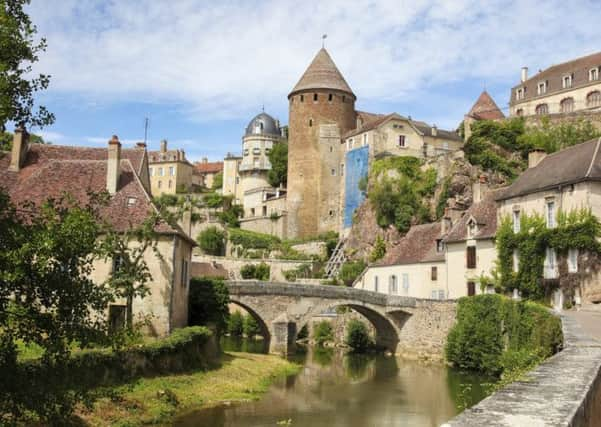Travel: Burgundy, France


WHAT do you know about Burgundy? I knew of its food, wine, mustard, and a little of its history. Now, after a visit I know more about the richness of its food – this is the home of boeuf bourguignon, and coq au vin, after all – and mustard seed grinding in the Fallot factory pricked our eyes and warmed our palates. As for the wine, a La Vinif tasting in Beaune taught us well. Throw in sobering facts from its history, plus a taste of modern luxury, and I know a whole lot more.
The luxury came at the end of the trip, in the north of Burgundy in Joigny, a town with its wealthier days behind it, but with some beautiful old houses, a castle and a luxurious hotel, Le Cote Sainte Jacques, at which chef/owner Jean Michel Lorain has garnered three Michelin stars. Its terraced gardens border a river, and the views are of water, swans, a few small boats and the park on the opposite bank. In the hotel’s spa, my husband and I relaxed with a joint treatment – a massage preceded by a wooden sleigh bath strewn with rose petals, accompanied by rose tea. At one point I closed my eyes and said to my husband: “I am being bumped by rose petals.” To which he replied from the other end of the bath: “There are worse things in life than being bumped by rose petals.” He had a point.
Advertisement
Hide AdAdvertisement
Hide AdWe had started in Dijon, a city of medieval origins, now home to businesses and a university. It’s a lively, prosperous-feeling place of wide squares, cobbled streets and many shops, bars and restaurants. One of the restaurants, where we sat at tables under the trees on a warm September night, was the site of the guillotine during the revolution. Our guide from the Dijon Tourist Office told us that long before the revolution there were the Dukes of Burgundy whose empire spread throughout Europe, and whose days of glory were the 14th century. And there in the Palais des Ducs, which houses the Musee des Beaux-Arts, we saw the proof, and marvelled at the altarpieces, and at their magnificent and elaborate tombs. Even in death; if you’ve got it, flaunt it.
We moved on, by train (the whole trip was Eurostar then SNCF trains) to another university city, Chalon sur Saône. It has Roman origins, streets of half-timbered houses from the middle ages, a museum devoted to early photography pioneer Nicéphore Niépce, and appropriately, a modern day Institute of Engineering with a reputation for its work in virtual reality. But it was the river and the streets that attracted me most. There are beautiful squares, one in front of the town hall, and, particularly, one in front of the cathedral, filled with shops and houses with overhanging fronts, cafes spilling out onto the pavements, and what appeared to be a very contented citizenry taking their ease.
On the train again to Beaune, another handsome city and another guided tour, this time of the Hospices de Beaune. Our guide told us of the dominance of religion in the middle ages, of the need to practise the seven virtues specified by the Church, every day. “Every day!” We all reeled back in horror, knowing that modern life does not include much faith, hope and charity, let alone prudence, temperance, fortitude, and justice. As always, there was a get-out clause involving money, and in 1443 Nicholas Rolin, the Chancellor of Burgundy, a bad boy of the times, expiated his sins by building this hospital for the poor.
The hospice frontage is plain and fortress-like, because it was built shortly after the Hundred Years War, when marauding bands roamed the country, the inhabitants of Beaune were destitute and plague was rife. A plain frontage was a protection for the glories within.
Once inside in the central courtyard we were surrounded by light and colour bouncing off the multicoloured and glazed tiles on the swooping roofs and the many dormers of the two wings. The nuns who operated the hospital welcomed the elderly, the sick, the disabled, the orphans, women in labour, and the destitute, and cared for them in these surroundings which must have been the ultimate in luxury in those days. The main hall, with its rows of cabin beds, has a large fireplace at one end, the only heating in the room. The beds were for two people, and the chapel at the other end allowed the sick to worship without leaving their beds.
In those times, the nuns with their white, sail-like headdresses and their herbal potions were the only help and salvation for the inhabitants, with the bitter cold of winter countered by nothing more than a fellow patient’s body heat.
Amazingly, the hospice remained in use until the 1970s, when everything was moved into a modern building. Now the charitable foundation that Rolin and his wife Guigone de Salins began is still involved in those original causes, and much enriched by centuries of donated vineyards, and a yearly wine auction held in the hospice.
We sat at a cafe across the street after our tour and in sight of the main door, where over the years desperate people had begged for admittance. Nothing like a glimpse of the past to make you grateful for our modern lives; for being able to travel, for food, for wine, and for a taste of present-day luxury, and being bumped by rose petals.
FACT FILE
Advertisement
Hide AdAdvertisement
Hide AdGlasgow Central to London Euston from £86.30 return. Eurostar.com travels London St Pancras to Paris from £69 return. See www.voyages-sncf.com for all train travel in France, and www.bourgogne-tourisme.com for information, tours and booking.
FOLLOW US
SCOTSMAN TABLET AND MOBILE APPS